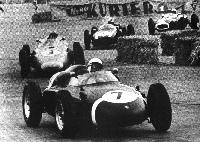Not quite the Österreichring but very near
Authors
- Mattijs Diepraam, Felix Muelas
Date
- 8W October 1998 issue
Related articles
- Stirling Moss - How Stirling got his Mercedes breakthrough, by Mattijs Diepraam/Felix Muelas
- Syracuse - Sicilian beauty and tradition, by Mattijs Diepraam/Felix Muelas
Why?
In 1960, there weren't many non-championship races run to F1 regulations. Only five British Trophy races were held outside the championship: the Glover Trophy at Goodwood, the International Trophy, the Silver City Trophy at Brands, the Lombard trophy at Snetterton and the Gold Cup, Innes Ireland in his Lotus winning three of these traditionals. In fact, 1960 was a transitional year, with the championship run to 2.5 litre regulations for the last time while several events chose to run their races to 1.5 litre F2 regulations, which were to become F1 rules the following year. Most of these events were blessed with a healthy entry of F2 cars-to-become-F1s since several outfits took the opportunity to test their machinery with next season already in mind.
The new airfield track near the Styrian town of Zeltweg was the host to the third edition of its Flugplatzrennen, the predecessor of the first Austrian GP at the same track in 1963. The race saw a splendid entry, headed up by Brabham's works Cooper, two factory Porsches driven by Hans Herrmann and Edgar Barth, and the private 718 of Stirling Moss, entered by Rob Walker. Adding to the quality of the field were three Centro Sud Coopers of Trintignant, Gregory and Cabral, while the Equipe Nationale Belge fielded Lucien Bianchi and 'Blary'. Though the entry was promising the race turned out to be a bit of a bore. This is how Paul Sheldon has recorded the events of the day (with apologies for his drama-laden prose...):
"Even today potential dramatic races can be destroyed by the unaccountable mechanical whims of machines. On the other hand races which seem drab on paper can occasionally rise to great heights. That is one of the great attractions of the sport. In this case the mechanical nemesis struck Jack Brabham and he retired early on in the race when the fuel pump decided [after heavy consultation with some other decision-making mechanical devices, we might think!] that it had not been given sufficient attention and stopped playing. This left Moss in command."
After Brabham's demise some sort of shadow fight started to evolve. Let's listen to Sheldon again: "Comment has been made before of the obligation that the professional drivers of this period felt to their paying public and on this occasion Moss realised [one assumes after talks with Jack Brabham's grumpy fuel pump!] that a lot of people had paid to see a motor race. So rather than stroking the car away to an easy and boring victory, he motored just fast enough to keep ahead of Herrmann while allowing the German to remain close enough to profit from any mistake the maestro might make. Needless to say, Moss did not make one and beat Herrmann by just over half-a-second with the second factory Porsche just a minute behind."
Moss remembers: "Since the Porsche had run so poorly in my last two outings, my confidence in it had been considerably dented. The works assured us of their best possible preparation for the Austrian GP which followed at Zeltweg aerodrome. Hans Herrmann and Edgar Barth drove the works cars there, while I returned in Rob's blue one, and we finished 1-2-3 with my car ahead after Jack Brabham had retired with fuel-pump trouble. The race was stopped three laps early because the crowds broke through to the track."
Here he is probably talking about that lot of spectators that had paid to see a motor race, but, unaware of traditions, and excited about Moss' professional obligation being so well fulfilled, had just decided to break through the barriers and thank him personally...

